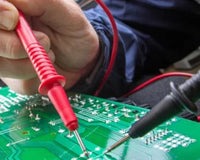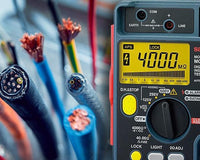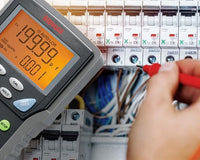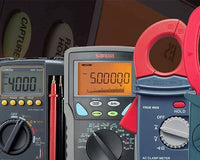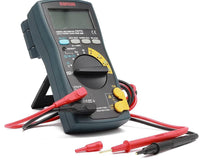A multimeter is an essential tool for anyone working in electrical engineering, contracting, electronics, or any other field that requires electrical measurements.
A multimeter can measure a number of electrical quantities including voltage, current and resistance, making it an indispensable tool for diagnosing electrical problems. In this article, we will discuss the most important multimeter features that are essential for anyone looking to buy a multimeter.
Also See:
Multimeter Test Functions
These are the primary test functions available on today’s multimeters. Most modern multimeters can perform at least a few of these tasks, depending on the model, with more functions available as you move up the product line.
Voltage Measurement
The most popular and essential feature of a multimeter is its ability to measure voltage. Voltage is the electrical potential difference between two points in a circuit and is measured in volts (V). Many multimeters can measure both AC and DC voltage, making them versatile for a wide range of electrical applications.
Current Measurement
Another essential feature of a multimeter is its ability to measure current. Current is the flow of electrical charge through a circuit and is measured in amperes (A). A multimeter can measure both AC and DC current, making it useful for testing electrical devices and circuits.
Resistance Measurement
A multimeter can also measure resistance, which is the opposition of a material to the flow of electrical current. Resistance is measured in ohms (Ω). A multimeter can measure the resistance of a component, a circuit, or a wire, making it essential for diagnosing faults in electrical devices.
Continuity Testing
Another popular feature of a multimeter is continuity testing. Continuity testing is used to check whether a circuit is complete, and there are no breaks or faults in the circuit. The multimeter emits a beep or a tone when a circuit is complete, indicating that there are no breaks or faults.
Diode Testing
A multimeter can also test diodes, which are electronic components that allow electrical current to flow in only one direction. Diodes are commonly used in rectifiers and voltage regulators. A multimeter can test whether a diode is working correctly or not by checking the forward and reverse bias voltage.
Temperature Measurement
Some multimeters can also measure temperature, which is essential for testing electronic components that may be affected by temperature changes. Temperature is measured in degrees Celsius (°C) or degrees Fahrenheit (°F), and a multimeter can measure temperature using a thermocouple or a temperature sensor.
Other Multimeter Features
Display Count
The display count refers to the number of digits displayed on the multimeter. This number varies from model to model, and the more digits the multimeter has, the more accurate the readings will be. For example, a 3½ digit multimeter can display numbers from 0 to 1999, while a 4½ digit multimeter can display numbers from 0 to 19999. A 5½ digit multimeter can display numbers from 0 to 199999. In general, the more digits a multimeter has, the more precise the measurements will be.
Auto-Ranging
Auto-ranging is a feature that allows the multimeter to automatically select the appropriate range for the electrical quantity being measured. This feature is convenient as it saves time and eliminates the need for the user to manually select the range.
Backlit Display
A backlit display is a useful feature of a multimeter that allows the user to read the display in low light conditions. A multimeter with a backlit display is particularly useful when working in dimly lit areas.
Datalogging
Some multimeters can log data, which is useful for recording measurements over time. This feature is particularly useful for diagnosing intermittent faults in electrical devices.
PC Connectivity
PC connectivity is a feature that allows the multimeter to be connected to a computer for data transfer and analysis. This is useful for storing data, creating reports, and analyzing trends. Some multimeters come with software that allows the user to graph data and analyze trends, which can be useful for diagnosing electrical problems.
True RMS
True RMS is a feature that is found in more advanced multimeters, and it allows the instrument to accurately measure AC voltage and current. AC voltage and current waveforms are not typically a perfect sine wave, and conventional multimeters may not accurately measure the true value of the voltage or current. True RMS multimeters use a more sophisticated method of measuring the voltage or current waveform, which allows them to accurately measure the true value.
Safety Features
Last but certainly not least, safety features are an essential consideration when selecting a multimeter. A multimeter should have overload protection to prevent damage to the multimeter or the device being tested. A multimeter should also have a rugged design and be able to withstand accidental drops and impacts.
Overload Protection
Overload protection is an essential feature of a multimeter, as it protects the instrument and the user from damage. If the multimeter is exposed to voltage or current levels that are higher than its maximum range, the overload protection feature will kick in and prevent damage to the multimeter. This is an important safety feature that protects the user and prolongs the life of the instrument.
In conclusion, a multimeter is an essential tool for anyone working with electrical devices or circuits. The most important multimeter functions include voltage, current and resistance measurement, continuity testing and diode testing. Other important features include temperature measurement, auto-ranging, backlit displays, data logging/PC connectivity and safety features such as overload protection. When selecting a multimeter, you should consider the features that are most relevant to your needs, and then choose a multimeter that is solidly built, reliable and safe to use.
Recommended meters:


